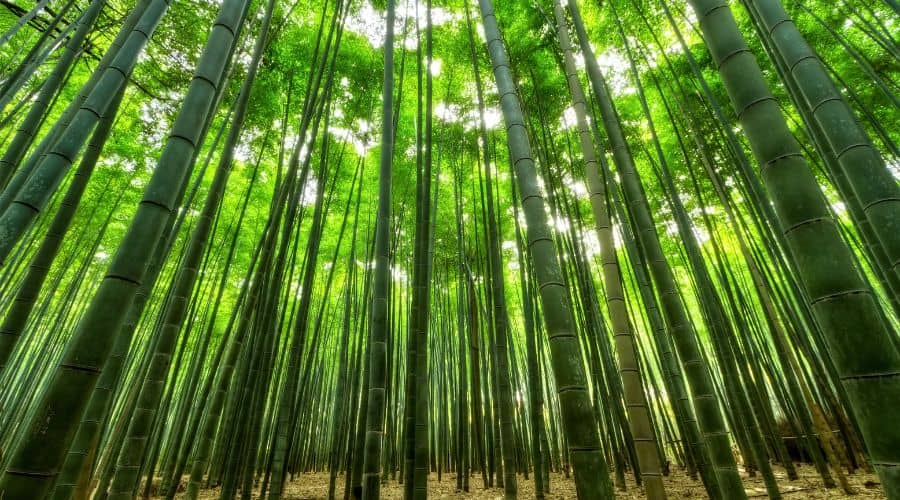
Bamboo is a tall plant with hard, hollow stems. Every part of the plant has its use making it one of the most sustainable and eco-friendly plants out there. This is why bamboo is such a favorite among people who care about the environment.
Despite being used for thousands of years, there are new ways in which this unique and versatile plant is being utilized today. There are a lot of interesting bamboo facts but it seems like we’re still learning new things about bamboo.
So, what’s so great about bamboo? Why are so many people raving about it?
Here’s a list of bamboo tree facts that will help you understand why there is such a bamboo craze today.
Facts About Bamboo
Facts about bamboo are numerous but we narrowed the list down to the most important.
1. Grows fast
Bamboo is the fastest growing plant in the world. It has been recorded at growing 47. 6 inches in 24 hours. A new bamboo shoot reaches its full height in less than a year. The largest bamboo species is the Dendrocalamus sinicus, which can grow up to 150 feet.
2. Releases more oxygen than any other tree
A groove of bamboo releases 35% more oxygen than any tree out there. You can feel the effects when you stand next to a clump of bamboo.
3. Efficient carbon dioxide absorption
Bamboo absorbs carbon dioxide at a rate of 17 tons per hectare every year. It can act as a valuable carbon sink given how fast the plant grows. It is a great way to fight climate change.
4. No fertilizer required
Bamboo doesn’t need fertilizer to grow. It can self-mulch by dropping its leaves and use the nutrients to grow. Pesticides, heavy machinery, and irrigation are also not required to grow healthy bamboo shoots.
5. Drought resistance
Bamboos are drought-tolerant plants. They can grow in the desert. Bamboos have shallow rhizomes and roots and therefore don’t require a lot of water. Giving the plants too much water can cause their roots to rot.
6. Wood replacement
Bamboos can be harvested in 3-5 years compared to the 20-30 years of most softwood trees. Hardwood trees can take up to 150 years before they’re ready to be harvested. Bamboos can also out yield pine trees at a ratio of 6 to 1. Instead of relying on these trees, the world can turn to bamboo for their building materials, furniture and more.
7. Building material
Bamboo is incredibly strong and sturdy. Bamboo has been used as support for concrete as well as scaffolding, bridges, and houses. It’s the main building material for over one billion people worldwide.
8. Soil stability
Bamboo has a wide network of underground roots and rhizomes that prevent soil erosion. This is because the roots and rhizomes bind the soil firmly. It also dramatically reduces rain runoffs which is a major cause of soil erosion. As such bamboo is used to reclaim ravines and degraded lands.
9. Natural air conditioner
Bamboo cools the air surrounding it by up to 8 degrees in the summer. You can use its cooling effect on your garden or home.
10. Antibacterial and antifungal
Bamboo is naturally antibacterial and antifungal. It has a natural antimicrobial bio-agent called Bamboo Kun. This bio-agent makes bamboos resistant to pests that would harm them. Bamboo Kun is typically found in the trunk of the plant. It’s so effective that it kills 70% of the bacteria that try to grow on it. This is why bamboos don’t need pesticides to grow.
11. Fire resistant
Unlike many plants, bamboos are hard to ignite. They can resist fires and temperatures up to 752 Fahrenheit. This is due to their naturally high percentage of silica content and boric acid which is a fire retardant. While the plants will eventually burn, they’re better than most plants.
12. Regenerative
Bamboos are naturally regenerative. Cutting down bamboo encourages growth. The cut bamboo stalk will simply make new leaves that will send nutrients to the root system. This encourages the growth of new shoots. Harvesting bamboo, therefore, causes growth without causing deforestation. This is why bamboo is such a valuable renewable resource.
13. Bamboo clothes
Bamboo clothing has recently become a big thing. The fibers made from bamboo pulp are woven into a soft bamboo fabric that is antibacterial, moisture-wicking, odor-resistant, and regulates temperature. The bamboo trees facts above should show why bamboo is an eco-friendly alternative to other fabrics.
Fun Facts About Bamboo
Here are some fun facts about bamboo.
14. Bamboo flowers once every 3 to 150 years
Most bamboo flowers bloom once every 3 to 150 years. Woody bamboo species are subject to what is called gregarious flowering. This means that flowers from all plants of a particular species bloom at the same time regardless of differences in location or climate.
15. Bamboo is Edible
Most bamboo species are edible. The new shoots are harvested while still soft and often used in Asian cuisine.
16. Perfect writing tool
No list of bamboo facts is complete without mentioning its historical importance. For thousands of years, bamboo has been used as both paper and a writing tool. Bamboo books have been used in China as early as 400 BC. Since Chinese characters are written vertically, only a single column of bamboo strip is needed. To make a book, bamboo strips are connected by threads.
Where Does Bamboo Grow?
Bamboo is indigenous to every continent except Europe and Antarctica. Non-native species of bamboo still grow in these two continents. This is because bamboo can grow in all kinds of climates from deserts to tropics.
What Is Bamboo Used For?
Bamboos are used for construction, furniture, fabric, food, paper, and charcoal.
How Many Species Of Bamboo Are There?
There are more than 1500 known species of bamboo in the world.
Is Bamboo a Tree?
No. Bamboo is not a tree, it’s giant grass. It is part of the Poaceae plant family which is a family of grass plants.
The bamboo facts stated above show why bamboo is important in the fight against climate change. It’s beneficial to ecosystems from preserving soil to releasing oxygen into the atmosphere. Bamboo is relatively easy to plant and harvesting it helps it grow faster.
If you want eco-friendly products, look for anything that is made from bamboo.
Sources:
- Bamboo Down Under: “20 Fun Facts About Bamboo”
- Lewis Bamboo: “Interesting Facts About Bamboo”
- The Third Pole: “Grow bamboo, capture carbon”, January 21, 2019
- International Bamboo and Rattan Organisation: “Scientific efforts to understand Bamboo better underway”, January 14, 2015
- One Tree Planted: “8 Amazing Bamboo Facts”, July 02, 2020
- Guadua Bamboo: “Bamboo is the Fastest Growing Plant on Earth”
- SmartClass4Kids: “Bamboo Plant Facts – Amazing facts about a bamboo plant for kids”
Related Articles:
- Bamboo Fabric In Clothing: Is Bamboo Fiber Sustainable?
- Best Bamboo Clothing 2022: 14 Bamboo Apparel Brands We Recommend

![]() Jamie - Cofounder
Jamie - Cofounder
Hi, I hope you enjoyed reading this article.
If you are looking for more ways to live an eco-conscious lifestyles, then check out our complete guide here.
Thanks for stopping by - Jamie


